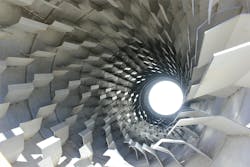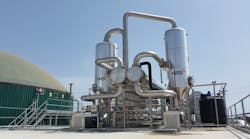Whether producing fillers, intermediary materials, or end products, an industrial drying step can be found in nearly every facility processing bulk solids. Producers rely on industrial drying systems to prepare material for use as a feedstock, as a finishing step in the production process, and more.
Often working to meet stringent quality standards and tight deadlines against small profit margins, producers require their drying systems to be efficient, reliable, and able to consistently produce material according to specification.
Both rotary dryers and fluid bed dryers can meet these objectives, which can make the choice between the two types unclear in some settings, particularly given the amount of overlap in applications historically seen. However, with each dryer type offering distinct differences, the choice between them often becomes clear when considering how each dryer operates. The resulting implications on the material and facility will often influence the decision of which dryer type to select.
Note: While indirect rotary dryers are available on the market, they are less common than direct rotary dryers and are not often compared with fluid bed dryers. As a result, the information provided in this article on rotary dryers is specific to the direct configuration.
Rotary dryer operation
A rotary dryer uses gravity and motion, combined with air flow, to move material through the unit. Material is passed through a horizontally rotating cylinder (the “drum”), which is set on a slight angle to encourage movement of material through the drum. Combustion gases are simultaneously passed through the unit at a predetermined velocity.
As the drum rotates, flights, or material lifters, pick up material and drop it through the air stream, creating a “curtain” of cascading material in the drum’s cross section that maximizes heat transfer between the material and the process gas. Combustion gases may be passed co-currently (parallel) or counter-currently to the material.
Fluid bed dryer operation
Unlike rotary dryers, which employ mechanical motion, fluid bed dryers are considered a type of pneumatic dryer, meaning that air flow alone moves material through the unit.
A fluid bed dryer consists of an enclosed vessel through which a predetermined velocity of air is passed from the bottom up via a perforated plate, causing the bed of bulk solid material to become suspended and behave in a fluidized state. Each particle is surrounded by air, making this approach to drying very thermally efficient.
How dryer operation influences dryer selection
By understanding how each dryer operates, one can begin to make decisions about what applications might be suitable for one type over the other. This is particularly evident when considering the following:
Energy consumption
The way each dryer operates has a significant influence on the amount of energy required.
Since fluid bed dryers rely on being able to suspend the material in the air flow, applications involving materials with large particle sizes or high bulk densities may require too much energy in a fluid bed dryer to be economically practical.
As such, materials with high bulk densities or larger particle sizes (greater than ½ to 1 inch) are typically better served by a rotary dryer, which instead uses mechanical motion to put material in contact with the air stream.
It is also important to note that because a certain amount of energy is required to reach minimum fluidization, a savings in energy is not applicable when running a fluid bed dryer at reduced capacity. In contrast, a rotary dryer does not require as much energy to dry lesser quantities of material, so producers can garner some energy savings when running at reduced capacity.
Thermal efficiency
A long-held myth often encountered in the industry is that the higher thermal efficiency of fluid bed dryers translates to lower fuel costs. Their high thermal efficiency does account for some savings in fuel, but that savings is negated when considering that they typically use lower inlet gas temperatures than rotary dryers.
Some savings in energy can be garnered in fluid beds by employing recirculated air from the exhaust gas system. However, this approach must be carried out with care; the use of recirculated air will also require some type of dust collection to avoid plugging the ductwork and the perforated plate. Recycled exhaust gas may also be slightly higher in moisture content, requiring higher product and exhaust gas temperatures to achieve the desired result, again, negating the thermal efficiencies gained.
When the totality of energy use and thermal efficiency is considered, these two dryer systems are comparable in fuel costs and energy consumption.
Material action in the dryer
Operation also influences material action, which can be an important consideration in some settings. Operation impacts both the action between particles and the action between particles and the dryer’s interior.
Rotary dryers pick up and drop material through the air stream, so materials that must not suffer degradation or that are particularly fragile may not be suited to this type of dryer.
When degradation is not a concern, or where granules have a suitable green (wet) strength, the tumbling action that occurs in the bed of the rotary dryer can offer an advantage by polishing granules. When processing rounded granules, this action helps to further round and refine the product. When working with jagged, irregular granules, such as those produced via compaction granulation, the tumbling action can knock off loose edges and reduce the amount of attrition in the final product.
Because they are not dropping material, fluid bed dryers inherently promote less material degradation, offering a gentler drying option, though some degradation is still possible due to the interaction between particles during fluidization.
Operational stability
The ability to reach fluidization relies on particles falling within a tight range of specifications, meaning that fluid bed dryers are often not suitable at plants where variation in feedstock moisture content, particle size, or otherwise, is possible. Such variation in particle characteristics quickly leads to process upsets when working with fluid bed dryers.
Rotary dryers, on the other hand, are much more tolerant of feedstock variation. Though it is important to note that feedstock uniformity should still always be a top priority, slight variation in particle size, moisture content, etc., will not lead to process upsets with a rotary dryer.
Operational stability also plays into the downtime and labor requirements associated with cleaning the unit. If a fluid bed dryer is shut down with an active bed, the bed will collapse, and material will fall through the distributor plate. This action, and the resulting mess, is referred to as “weep.” The area below the distributor plate will then require cleaning before operation can resume.
Conversely, a rotary dryer shut down during production can simply be restarted, so facilities expecting frequent shutdowns may be better served by rotary dryers.
Ease of operation
In addition to a uniform feedstock, proper fluidization also requires a careful balance of air flow and system pressures to maintain adequate fluidization, as well as to avoid short circuiting (a term used to describe when the product consists of both fully dried and undried material).
For these reasons, fluid bed dryers require more supervision; operators need a more advanced understanding of the unit and their production line and must carefully monitor the operation to prevent upsets and ensure that the finished product consistently meets specification.
Capacity
The inherently larger size of rotary dryers means they are capable of handling higher throughputs than fluid bed dryers. This is essential for high-capacity production facilities but may be overkill in settings requiring something smaller, where a fluid bed dryer would be a more practical approach.
For facilities in which the fluid bed dryer is applicable and capacity requirements are within its range, the fluid bed dryer is the obvious choice, offering a cost-effective option.
Dryer infrastructure/Facility requirements
The supporting systems and other facility-related factors may also influence dryer selection.
Available space
Assuming that the fluid bed can meet capacity requirements, facilities working with limited space will often select a fluid bed dryer, due to its much smaller footprint.
Off-gas treatment and particulate capture
Both dryer types require exhaust gas treatment and particulate capture. The larger air volume required to achieve fluidization, however, necessitates a larger off-gas treatment system.
There is also a greater potential for fine material to be carried away by the exhaust gas system with a fluid bed dryer, requiring more robust particulate capture (typically a baghouse and/or cyclone separator) compared to a rotary dryer.
Maintenance
Though they are still considered relatively low-maintenance, because rotary dryers have more moving mechanical components, they require a bit more maintenance compared to fluid bed dryers.
CAPEX and OPEX
Not surprisingly, the project budget also has a significant influence on the decision between dryer types.
Fluid bed dryers are a lower-cost option, making them ideal for smaller-scale operations, but as has been demonstrated, they are not always a fit. Further, the additional labor requirements, greater potential for downtime, and other factors have the potential to inflate operating costs.
While rotary dryers come at a higher price point, they are often favored for their simple and reliable operation.
All of these factors are important considerations that must be balanced in evaluating the CAPEX and OPEX associated with each dryer type.
Concluding remarks
Both rotary and fluid bed dryers offer an effective, efficient approach to drying a wide range of bulk solids. Despite their overlap in capabilities, however, the best dryer type for a given project can often be best determined by considering how each dryer’s operation will impact the material and facility. Those unsure of which system will suit their application best should work with a qualified OEM to guide their decision.
Nick Reckinger is a process sales engineer at FEECO International, a supplier of custom process equipment, process development services, and service support to the global industrial processing industry.
FEECO International
www.feeco.com



